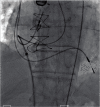Transcatheter Closure of Iatrogenic VSDs after Aortic Valve Replacement Surgery: 2 Case Reports and a Literature Review
- PMID: 27547145
- PMCID: PMC4979393
- DOI: 10.14503/THIJ-15-5083
Transcatheter Closure of Iatrogenic VSDs after Aortic Valve Replacement Surgery: 2 Case Reports and a Literature Review
Abstract
We report 2 new cases of transcatheter closure of iatrogenic ventricular septal defects after aortic valve replacement surgery, together with our finding, in a literature review, of 9 additional patients who had undergone this procedure from 2004 through 2013. In all 11 cases, transcatheter device closure was indicated for a substantial intracardiac shunt with symptomatic heart failure, and such a device was successfully deployed across the iatrogenic ventricular septal defect, with clinical improvement. Our review suggests that transcatheter closure of iatrogenic ventricular septal defects in patients with previous aortic valve replacement surgery is a safe and effective treatment option, providing anatomic defect closure and relief of symptoms in the short-to-medium term.
Keywords: Aortic valve insufficiency/replacement/surgery; catheterization; echocardiography, transesophageal; heart septal defects, ventricular/therapy; iatrogenic disease; septal occluder device; ventricular septum/injuries.
Figures
Similar articles
-
Transcatheter membranous ventricular septal defect closure through a mechanical aortic prosthesis using the Amplatzer membranous ventricular septal defect occluder.Catheter Cardiovasc Interv. 2009 Feb 1;73(2):167-72. doi: 10.1002/ccd.21794. Catheter Cardiovasc Interv. 2009. PMID: 19085913
-
Novel transcatheter closure of an iatrogenic perimembranous ventricular septal defect.Catheter Cardiovasc Interv. 2015 Jan 1;85(1):161-5. doi: 10.1002/ccd.25651. Epub 2014 Sep 13. Catheter Cardiovasc Interv. 2015. PMID: 25176592
-
Percutaneous Ventricular Septal Defect Closure After Sapien 3 Transcatheter Aortic Valve Replacement.JACC Cardiovasc Interv. 2015 Jun;8(7):e109-10. doi: 10.1016/j.jcin.2015.01.034. Epub 2015 May 20. JACC Cardiovasc Interv. 2015. PMID: 26003030 No abstract available.
-
When to close iatrogenic atrial septal defect after percutaneous edge to edge repair of mitral valve regurgitation.Cardiovasc Revasc Med. 2016 Sep;17(6):421-3. doi: 10.1016/j.carrev.2016.04.005. Epub 2016 Apr 25. Cardiovasc Revasc Med. 2016. PMID: 27162141 Review.
-
Left ventricular geometry and systolic function improvement after percutaneous closure of aortic prosthetic paravalvular leak.J Heart Valve Dis. 2013 Nov;22(6):862-6. J Heart Valve Dis. 2013. PMID: 24597411 Review.
Cited by
-
Percutaneous Closure of an Iatrogenic Inlet Ventricular Septal Defect in an Atrioventricular Canal.JACC Case Rep. 2020 Jun 17;2(6):911-914. doi: 10.1016/j.jaccas.2020.05.011. eCollection 2020 Jun. JACC Case Rep. 2020. PMID: 34317380 Free PMC article.
-
Transcatheter Closure of Residual and Iatrogenic Ventricular Septal Defects: Tertiary Center Experience and Outcome.Pediatr Cardiol. 2022 Feb;43(2):308-323. doi: 10.1007/s00246-021-02722-x. Epub 2021 Sep 8. Pediatr Cardiol. 2022. PMID: 34495353
References
-
- Al-Kashkari W, Balan P, Kavinsky CJ, Cao QL, Hijazi ZM. Percutaneous device closure of congenital and iatrogenic ventricular septal defects in adult patients. Catheter Cardiovasc Interv. 2011;77(2):260–7. - PubMed
-
- Holzer R, Latson L, Hijazi ZM. Device closure of iatrogenic membranous ventricular septal defects after prosthetic aortic valve replacement using the Amplatzer membranous ventricular septal defect occluder. Catheter Cardiovasc Interv. 2004;62(2):276–80. - PubMed
-
- Klein AJ, Garcia JA, Carroll JD. Percutaneous closure of an iatrogenic ventricular septal defect following mechanical aortic valve replacement using the transseptal technique. Catheter Cardiovasc Interv. 2007;70(7):1018–24. - PubMed
-
- Dodos F, Fehske W, Hoppe U, Sreeram N. Transcatheter closure of iatrogenic perimembranous ventricular septal defect following prosthetic aortic valve replacement. Clin Res Cardiol. 2008;97(1):53–5. - PubMed
-
- Chojnicki M, Sukiennik A, Anisimowicz L, Swiatkiewicz I, Pawliszak W. Transcatheter closure of iatrogenic perimembranous ventricular septal defect after aortic valve and ascending aorta replacement using an Amplatzer membranous ventricular septal occluder. Cardiol J. 2008;15(2):189–91. - PubMed
Publication types
MeSH terms
LinkOut - more resources
Full Text Sources
Other Literature Sources



